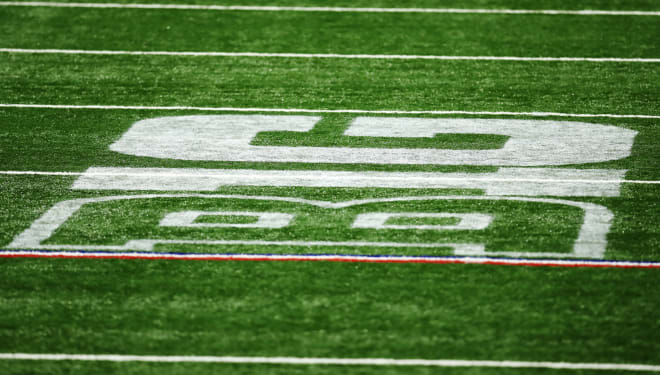Big Ten meetings: Collectives, scheduling, divisions, TV and more

MORE: Big Ten coach: NIL, transfer portal have been 'disaster' for college sports | What's future of Big Ten schedules, divisions?
Collectives.
They are a topic of much discussion when it comes to college sports. And, they were front-and-center of conversations at Big Ten meetings in Phoenix this week.
"I can't speak on what others are doing," said Illinois coach Bret Bielema. "It's such an unchartered world that no one knows how to handle it."
Collectives weren't the only subject discussed at the Big Ten meetings. Conference scheduling, the future of divisions, the coming blockbuster TV contract and abolishing yearly limits on signing classes also were topics.
But, it's collectives--booster-fueled pools of money used to fund Name, Image and Likeness efforts at schools--that have league coaches, administrators and fans atwitter.
Making Big Ten leaders even more antsy is how aggressive the SEC has been when it comes to embracing, developing and implementing collectives--and often seemingly using them as recruiting inducements ... which isn't their intended purpose.
“Talking with some of the people, there are probably less collectives in the Big Ten,” said a conference source at the meetings. “The SEC is the one that's really crushing it, probably abusing it ...
"There's gonna be some task force come out with some rules on it here as early as Monday. They're gonna attempt to enforce it."
An NCAA working group will soon publicize NIL guidelines, per an SI.com report. And additional guidelines are expected to help regulate NIL rules.
What's the plan for the Big Ten?
“Well, it's so early now,” said the league source. “You're gonna have to do something. It's just a matter of ... there's a fine line if you just start paying all these new recruits, then what are the people on your team gonna say?
“So, you gotta be careful how you handle it. I'm not standing on the table to just start paying everybody, but I think we have to have some money available to be able to use.”
• Big Ten scheduling also was a topic in Phoenix, as expected. Would the league ever move away from a nine-game conference slate?
"I don't think that nine games will ever change,” said the league source.
The future of the East-West division format also was a subject of conversation.
“I think (divisions) created great rivalries,” said a Big Ten head coach. “We've already had enough change over the last decade going from at least in the Big Ten what were Legends and Leaders and now to East-West. I think there's really good rivalries on both sides.”
But, change may be brewing.
“The divisions may not change this year, but it's probably 50-50 that it could change beyond. Just get rid of them,” said the source.
"Pretty much all the teams in the West don't want to be part of (divisions breaking up). And all the teams in the East probably do. So, you know how that is. It's whatever's best for each individual team.”
It's believed that not having divisions would augment the Big Ten's ability to get more teams in an expanded 12-team College Football Playoff that is likely coming.
• A robust new TV deal also was big news in Phoenix, with reports stating Big Ten commissioner Kevin Warren expects to have an agreement in place on a new media rights contract in about a month. The new deal would begin in 2023 and could be worth a record-setting $1 billion per season, according to Sports Business Journal.
“It'll be a big deal whenever it comes out,” said a second Big Ten head coach. “I just do think that, as we all know, those decisions drive a lot of things. I think it could have something to do with the divisions. It's whatever's best for the TV market in the way it's going to help our conference be watched and viewed. Whatever is better for that, I think it's probably gonna drive it.”
Added the league source: "I think we're in the driver's seat, TV-wise. I think we're in a pretty good spot, according to what they think.
"I did hear that even the CBS 3:30 p.m. (ET) spot, they can be coming after the Big Ten since now the SEC is all ESPN, ABC. Right now, the FOX noon game actually out did all of them. And the CBS time slot was second. So, if we got both time slots, that would be big.”
What about streaming?
"They talked about it briefly and just got opinions,” said the source. “In my opinion, I think this stuff's important. I still think the major networks are more important. I think they're gonna slightly dip into it. But not to a big degree.”
• Conference coaches also talked about a likely coming change to the paradigm of recruiting classes. To wit: The days of signing just 25 players per year may be ending.
“It's antiquated,” said Bielema. “They're using NCAA recruiting rules that were for a non-portal world.
“When I took over as the head coach, there's naturally going to be a transition of the roster. We couldn't even get to 85 scholarships. There will be schools this year that may have only 60, 65, 70 kids on scholarship, because they hit the 25/7 rule (25 initial counters/seven extras to replace transfers) and they can't keep signing kids.”
The “initial counters” rule was established in 2011. But now, coaches are often having issues reaching the 85-scholarship limit primarily because of the free movement permitted by the portal, which began in 2018.
A proposed change: Add as many players (combination of initial counters and transfers) in a given year as needed to reach the 85-scholarship threshold.
"It could happen as early as August,” said the Big Ten source. “Or, they may wait until after the season. I think it's gonna happen here soon."
Membership Info: Sign up for GoldandBlack.com now | Why join? | Questions?
Follow GoldandBlack.com: Twitter | Facebook | YouTube
More: Gold and Black Illustrated/Gold and Black Express | Subscribe to our podcast
Copyright, Boilers, Inc. 2022. All Rights Reserved. Reproducing or using editorial or graphical content, in whole or in part, without permission, is strictly prohibited.

